The Intel Core Ultra 7 155H Review: Meteor Lake Marks A Fresh Start To Mobile CPUs
by Gavin Bonshor on April 11, 2024 8:30 AM ESTASUS Zenbook 14 OLED UX3405MA: Battery & Thermal Performance
While battery life is normally one of the key aspects of a notebook computer to begin with, Ultrabooks and other thin-and-light laptops in particular live and die by battery life. As they're designed to provide much longer battery life in order to enable (and sustain) on-the-go computing, while lacking the space and weight to pack a large 80 Wh+ battery, thin-and-light laptops live on the knife's edge in delivering on their battery life claims.
With Intel taking a mobile-first path with their Meteor Lake architecture, power consumption and battery life is an area where the architecture is intended to shine. And especially in the case of the ASUS Zenbook, which is an Evo-certified laptop, there are Intel co-engineering resources and performance requirements that come with it. Particularly in the case of battery life/energy efficiency.
The ASUS Zenbook 14 OLED UX3405MA comes with a battery rated at 75 Wh, with a supplied 75 Wh Type-C AC adapter for charging. Given that the Intel Core Ultra 7 155H has many associated TDP values from Intel, e.g., 115 W maximum turbo TDP, 28 W base TDP, and a MAP TDP of 65 W. We know from our power analysis that this notebook operates at between 28 and 65 W, which should give this particular Ultrabook some swing regarding overall battery life.
UL Procyon: Video Playback
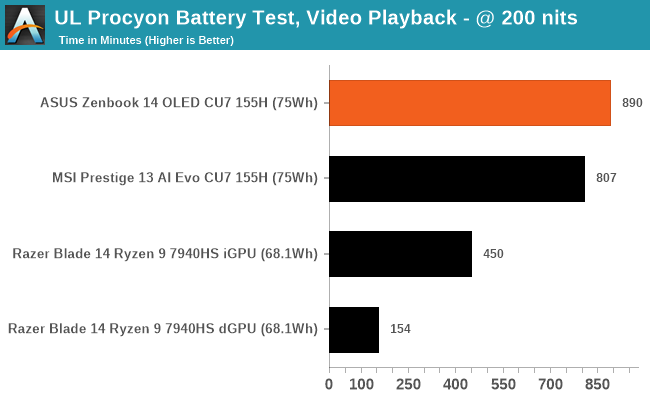
Using UL Procyon's video playback benchmark with the brightness calibrated to 200 nits, we can get a baseline battery life figure. UL Procyon's video playback test incorporates multiple HD videos and runs until the battery is empty. This includes 1080p YouTube quality video at 30 fps, with square pixels at NTSC level, and VBR 2 pass bitrate encoding with 10 Mbps.
Within the UL Procyon Video Playback test, the ASUS Zenbook 14 OLED achieved an impressive 890 minutes before the battery died. This translates into just under 15 hours of battery life, showing solid power efficiency, especially compared to the Razer Blade 14 running on the Radeon 780M integrated graphics. Compared to the MSI Prestige 13 AI Evo A1MG, which is also powered by the Core Ultra 7 155H processor and includes a 75 Wh battery, the ASUS lasted a whole 83 minutes longer in this test.
UL Procyon: Office
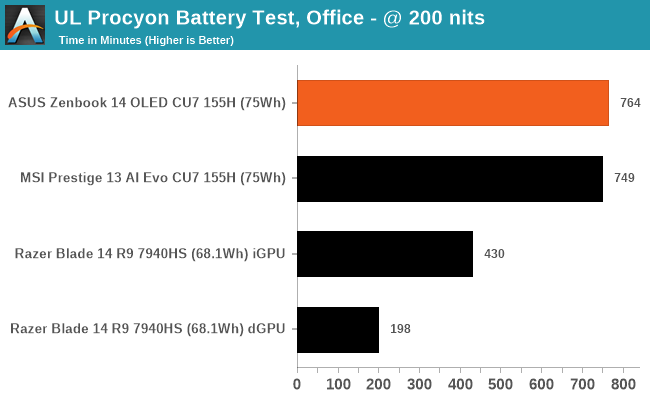
Using UL Procyon's office-focused battery test, we got up to 890 minutes of battery life on the ASUS Zenbook 14 OLED before the battery was fully depleted. The test itself is quite intensive, with numerous Microsoft Office 365-based workloads in the foreground and background. Compared to the MSI Prestige 13 AI Evo A1MG, which is also powered by the Core Ultra 7 155H processor and comes with a 75 Wh battery, the ASUS offers 15 minutes of additional battery life.
Charging Time
Included with the ASUS Zenbook 14 OLED UX3405MA ultrabook is a 65 W AC Type-C charger, which is quite compact and, unlike some brands, uses a widely (if not universally) accepted charging connector. It's also relatively low profile, barring the plug, and comes with a smooth cable similar to a 3-pinned cable for a desktop PC. Overall it is very light compared to a charger that comes with a gaming notebook, so portability is assured.
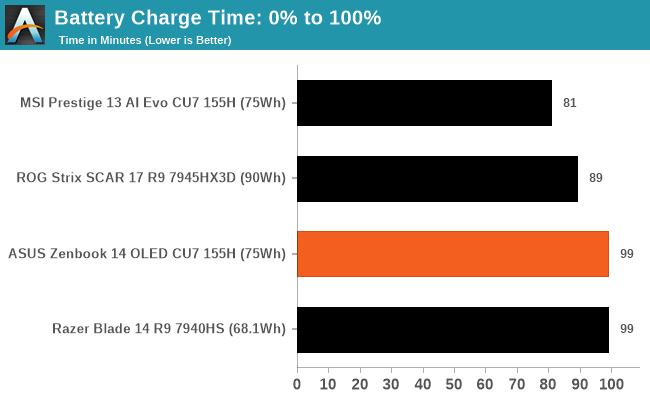
Using the included 65 W Type-C AC charger, the ASUS Zenbook 14 OLED charged from 0% to 100% in 99 minutes, the same time it took to charge the Razer Blade 14 (2023) model. In contrast, it took just 81 minutes to charge the competing MSI Prestige 13 AI Evo A1MG ultrabook.
ASUS Zenbook 14 OLED UX3405MA: Thermal Performance
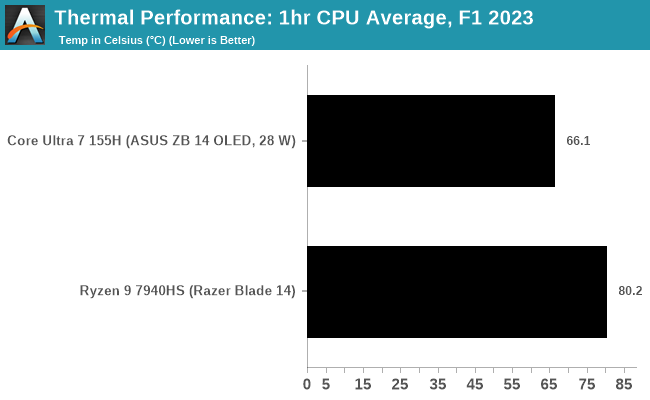
The Intel Core Ultra 7 155H relies solely on integrated graphics, so we're focusing on CPU package temperatures here. Interestingly, the ASUS Zenbook 14 OLED and MSI Prestige 13 Evo with the Core Ultra 7 155H averaged between 66 and 66.5°C, showing that both notebook manufacturers intended this before limitations and throttling kicked in. We know that the power throttles in heavily multi-threaded workloads on the ASUS model from our power analysis, but given the TJ Max is 110°C on the 155H, the reduction in power and temperature is more for the user experience to ensure the notebook chassis isn't burning through your lap.


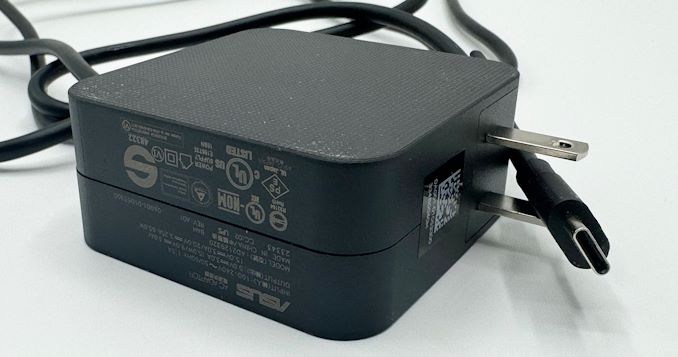








69 Comments
View All Comments
jeenam - Friday, April 12, 2024 - link
I've been an anandtech reader since 1998 or so and I'm not here to pick a bone. I'm a fan, and hope AT lives on. But did a quick search and the only two major websites with GPU reviews that referenced Returnal or Company of Heroes were Hot Hardware and Ars Technica. An expanded test suite of games might have been more appropriate because it's likely the ARC GPU would have been handily beaten across the board. Replysjkpublic@gmail.com - Thursday, April 11, 2024 - link
Strange. Some of the tests list the 155H as 28W with test results. This is misleading as the SoC uses much more power doing the test. ReplyGavin Bonshor - Friday, April 12, 2024 - link
When we review CPUs, especially when highlighting them in the charts, we list the base TDP, as every motherboard has its own interpretation of what level of power it will push through the chip (Multi-core enhancement). ReplyCarmen00 - Friday, April 12, 2024 - link
Yet in another comment, we have Ryan Smith saying "With these integrated devices, we're reviewing the notebook as much as we're reviewing the chip inside."So if you're doing what he says—post the right numbers, because that's what you're doing. And if you're NOT doing what he says, then don't post useless stuff that seems, to my (perhaps overly-critical eye) to exist so that the article can claim that Intel is scoring SOME kind of a win, when the graphs really don't seem to show a heck of a lot of CPU-related win.
I'm fine with either, let me be honest. But I want to see some consistency, that is all. Reply
Ryan Smith - Friday, April 12, 2024 - link
I'm all for trying to make sure you guys get the data that you want to see. But not sure I follow here. We are being consistent in our testing methodology, and taking care to be explicit in that our test systems don't have identical TDPs.https://images.anandtech.com/doci/21282/Core%20Ult...
In a laptop, sustained TDPs are our primary concern, as these devices cannot turbo multiple cores for more than a few seconds. So this is what we're noting in an article like this, to illustrate how we aren't testing devices with matching TDPs. Reply
ballsystemlord - Friday, April 12, 2024 - link
I agree with Ryan here, sustained performance is what you should be looking at. Anything can turbo to infinity.The only real use case for turbo, would be application start-up. But even then, you'd have to be waking the PC from idle and selecting the application in record time for it to matter at all. Reply
lmcd - Wednesday, April 17, 2024 - link
The problem I'm seeing is that this article takes the format of previous laptop reviews but not the depth (in part due to the declining access this publication), and the headline could better fit the contents. It could even be something silly like "The Intel Core Ultra 7 155H Review: Meteor Lake starts with a Moment of Zen(Book)" and be more valuable to the reader.It also did not feel like we really got (even a rehash of) an overview of Meteor Lake as a platform. So to me, this was an ASUS Zenbook review. Framing this as "ASUS ZenBook 14 OLED: A Meteor Lake Thin&Light Review" also better captures its content. Reply
eastcoast_pete - Friday, April 12, 2024 - link
I am not surprised that the Core 7 Meteor Lake isn't beating the Ryzen 7840HS in compute or graphics - that particular Ryzen 4 monolith is (IMHO) currently AMD's best foot forward, and a great APU. However, Intel did do its homework when it comes to the intended use of Meteor Lake SoCs: mobile, especially light and ultralight laptops and 2-in-1s. I don't expect a ~ 1 kg notebook to do that much higher level gaming or compute. I do expect long runtime on battery, fluid use of office and other productivity apps, and otherwise decent performance (speed). Again, AMD's Phoenix/Hawk APUs are, right now, the most performant solutions in that class, but it's good news for all of us that Intel has closed the gap. It'll mean that AMD will have to keep evolving its APUs, and maybe do a better job making them broadly available with good drivers within a few months of announcing them. Because that was not the case with Phoenix, which just took too long to be ready for prime time, and left the opening for Intel to move back into.Lastly, I find that one of the most remarkable things about Meteor Lake is that Intel got its tile design and packaging working quite well. Being able to combine different chips from different fabs (Intel and TSMC) and nodes into a cohesive unit without incurring large hits on performance and efficiency is big step forward. Reply
nandnandnand - Saturday, April 13, 2024 - link
Lunar Lake will be the one to watch. It's Meteor Lake-U evolved (4+4 instead of 2+8, on-package memory by default, decent graphics). Low power mobile chips are more interesting than the 45W+ ones. Replymode_13h - Monday, April 15, 2024 - link
> Being able to combine different chips from different fabs (Intel and TSMC)> and nodes into a cohesive unit without incurring large hits on performance
> and efficiency is big step forward.
AMD combined chiplets from both TSMC and Global Foundries in the same CPU, all the way back in Zen 2! If you count HBM, they combined chiplets from different foundries as far back as their HD Fury GPUs.
As for performance and efficiency, I find Meteor Lake underwhelming on both fronts. Idle performance and things like video playback gain a benefit from the new SoC architecture, but when it comes to compute-intensive tasks, we see why Intel kept around Raptor Lake for the performance-oriented segment. Reply